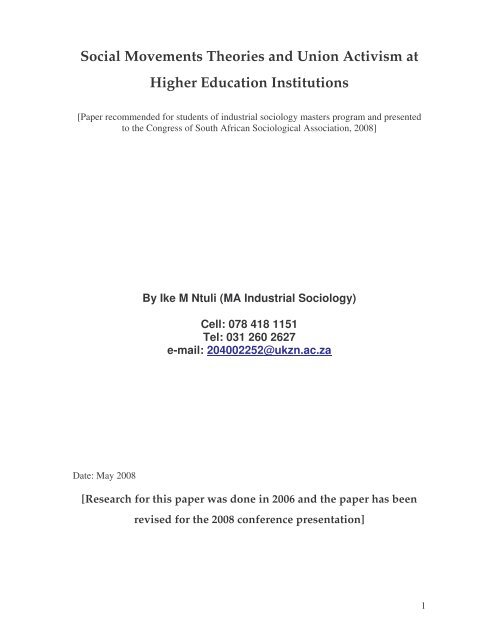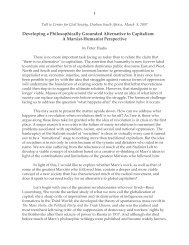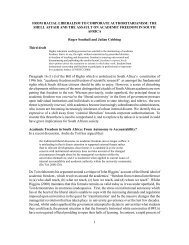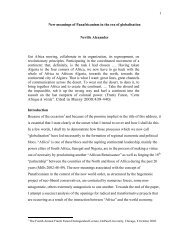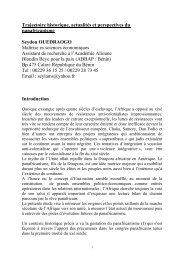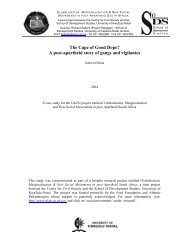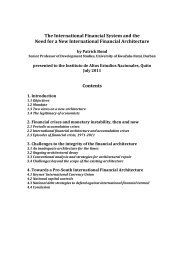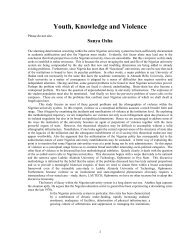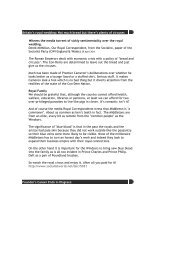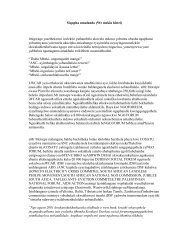Read Publication - Centre for Civil Society - University of KwaZulu ...
Read Publication - Centre for Civil Society - University of KwaZulu ...
Read Publication - Centre for Civil Society - University of KwaZulu ...
Create successful ePaper yourself
Turn your PDF publications into a flip-book with our unique Google optimized e-Paper software.
Social Movements Theories and Union Activism at<br />
Higher Education Institutions<br />
[Paper recommended <strong>for</strong> students <strong>of</strong> industrial sociology masters program and presented<br />
to the Congress <strong>of</strong> South African Sociological Association, 2008]<br />
Date: May 2008<br />
By Ike M Ntuli (MA Industrial Sociology)<br />
Cell: 078 418 1151<br />
Tel: 031 260 2627<br />
e-mail: 204002252@ukzn.ac.za<br />
[Research <strong>for</strong> this paper was done in 2006 and the paper has been<br />
revised <strong>for</strong> the 2008 conference presentation]<br />
1
1. Introduction<br />
This paper is concerned with the theoretical framework involving the use <strong>of</strong> social movements<br />
approach to union activism. The reader should note two assumptions here with regard to trade<br />
unions. First, trade unions are seen as kinds <strong>of</strong> social movements because they are organized<br />
social <strong>for</strong>mations challenging the existing power relations and decision-making processes in the<br />
workplace. Second, trade unions are very crucial in the conception and execution <strong>of</strong> the idea <strong>of</strong><br />
freedom as brought about by developmentalists in both the economic and the political arenas <strong>of</strong><br />
social life.<br />
These two sets <strong>of</strong> theories will together be used to examine the reasons behind the necessity <strong>of</strong><br />
trade unions and the benefits that arise from trade union activism. Concepts in these theories<br />
include social movements, factors motivating people to join or otherwise, unions or movements;<br />
social capital, development; freedom in its broad sense to include the economic, social, cultural as<br />
well as political aspects <strong>of</strong> the term. The overall conclusion, however, is that unions at higher<br />
education institutions are very important as they seem to be the only vehicle in the sense <strong>of</strong> a<br />
‘movement’ at the workplace with the statutory mandate to challenge decision-makers in the<br />
workplace. Unions, in this sense, are in a good position to empower their members and the latter<br />
could accrue more ‘freedoms’ in both their personal lives as well as in more political / public life in<br />
the sense <strong>of</strong> participation in public plat<strong>for</strong>ms and debates and to challenge undemocratic systems.<br />
2. Social Movements Theory<br />
2.1. Introduction<br />
This paper will focus on two interrelated dimensions <strong>of</strong> social movements, social movement<br />
organization development; and collective action. Sale (1992) and Brulle (2000, 2003) argue that<br />
“collective action in the <strong>for</strong>m <strong>of</strong> protests, lobbying and other attempts to change public opinion,<br />
social practices and public policy has grown significantly”. Cultural theories (Melucci, 1989, 1996;<br />
Rochon, 1998; Snow, 2004; Williams, 2004) analyze the idea <strong>of</strong> social movements by pointing out<br />
the <strong>for</strong>mation <strong>of</strong> new discursive frames and “critical communities,” i.e. “that [social movements] are<br />
networks <strong>of</strong> people who think intensively about a particular problem and who develop over time a<br />
shared understanding <strong>of</strong> how to view that problem”. Similarly, Diani and McAdam (2003) argue<br />
that “we can view movement networks as a reflection <strong>of</strong> the logic <strong>of</strong> action by which social<br />
movements select their allies, pool resources, and build identities which go beyond the boundaries<br />
<strong>of</strong> any single social movement organization”.<br />
2.2. Conceptual origins <strong>of</strong> social movements<br />
Another important aspect is the interaction between social movements and both external political<br />
authorities and organized counter movements. This interaction has important consequences <strong>for</strong><br />
the process <strong>of</strong> cultural change (Earl 2004). According to Jenkins and Brulle (2004), from a cultural<br />
viewpoint, changes in social structures are brought about through a redefinition <strong>of</strong> what constitutes<br />
the common sense embodied in the everyday practices <strong>of</strong> society. Accordingly, Bourdieu (1985, p.<br />
729) holds that control over the symbolic definition <strong>of</strong> reality is the basic <strong>for</strong>m <strong>of</strong> political power;<br />
“knowledge <strong>of</strong> the social world and more precisely, the categories that make it possible, are the<br />
stakes, par excellence, <strong>of</strong> political struggle, the inextricably theoretical and practical struggle <strong>for</strong><br />
the power to conserve or trans<strong>for</strong>m the social world by conserving or trans<strong>for</strong>ming the categories<br />
through which it is perceived”. This makes it possible to see the dynamics <strong>of</strong> the political society as<br />
being based on the relationship between the dominant discourse and the challenges to this<br />
discourse made by social movement organizations based on an alternative discursive frame. This<br />
competition between the dominant and alternative discursive frames is captured by Gramsci’s<br />
theory <strong>of</strong> cultural hegemony (Mann, 1970). For Gramsci, the successful mobilization and<br />
reproduction <strong>of</strong> the active consent <strong>of</strong> the dominated groups by the ruling class is made possible<br />
through the ruling class’ exercise <strong>of</strong> intellectual, moral and political leadership (Mann, 1970).<br />
2
These hegemonic ideas <strong>for</strong>m a collective will that unifies a historic bloc, he argues. There is then a<br />
war <strong>of</strong> position between the ruling bloc and its hegemonic ideas, and an alternative bloc based on<br />
an alternative reality in the <strong>for</strong>m <strong>of</strong> a social movement (Touraine 1977 p. 25-26). The emergence<br />
<strong>of</strong> movement identity occurs when the dominant and legitimate discourse clashes with this<br />
alternative discursive frame <strong>of</strong> the social movement (Jenkins and Brulle, 2004). This creates the<br />
perception <strong>of</strong> a group and symbolic reality outside <strong>of</strong> the taken <strong>for</strong> granted social reality (Cathcart,<br />
1980), and leads to a competition over the applicable and legitimate definition <strong>of</strong> the situation.<br />
As explained by Cathcart (1980: 72), these challenges define the development <strong>of</strong> a social<br />
movement. Cathcart held that the competition over cultural hegemony led to the rise <strong>of</strong> the<br />
movement in three key components. First, there is the interaction between movement and<br />
countermovement. As Meyer and Staggenborg (1996) argue, one <strong>of</strong> the strongest stimuli <strong>for</strong><br />
movement activity is counter movement activity, and vice versa, which <strong>of</strong>ten creates conflict spirals<br />
and intense hostilities. Second is the response <strong>of</strong> political authorities, which is critically shaped by<br />
movement discourses. Jenkins and Brulle (2004) argue that generally, social movement<br />
organizations promoting moderate discourses are facilitated while more radical discourses are<br />
typically repressed or shunted aside. Third is the larger cultural impact <strong>of</strong> movement mobilization,<br />
which involves bringing resources together to counter <strong>for</strong>ces that impact on their daily lives<br />
(Cathcart, 1980, p. 72-73).<br />
2.3. Types <strong>of</strong> social movements<br />
Types <strong>of</strong> social movements include, inter alia 1 , re<strong>for</strong>m movements, radical movements, innovation<br />
movements, group-focussed movements as well as conservative movements.<br />
Re<strong>for</strong>m movements are movements dedicated to changing some norms, usually legal ones.<br />
Examples <strong>of</strong> these movements would include trade unions with a goal <strong>of</strong> increasing workers’<br />
rights, a green movement advocating a set <strong>of</strong> ecological laws, or a movement supporting<br />
introduction <strong>of</strong> a capital punishment or right to abortion. Importantly, these movements do not<br />
concern themselves with change in the overall social structure or the political status quo, but<br />
rather, are concerned with changes in some parts or aspects <strong>of</strong> the social system.<br />
Radical movements are movements dedicated to changing some value systems, and are usually<br />
much larger in scope than the re<strong>for</strong>m movements. Examples would include the American civil<br />
rights movement which demanded full civil rights and equality under the law, regardless <strong>of</strong> race;<br />
the Polish Solidarity movement which demanded the trans<strong>for</strong>mation <strong>of</strong> communist political and<br />
economic systems into democracy and capitalism; the Liberation movement led by the African<br />
National Congress (ANC) which carried out political struggles on behalf <strong>of</strong> the majority <strong>of</strong> the<br />
oppressed black people in the pre-1994 South Africa.<br />
Innovation movements are movements which want to introduce new norms, values, etc. The<br />
singularitarianism movement advocating deliberate action to effect and ensure the safety <strong>of</strong> the<br />
technological singularity is an example <strong>of</strong> an innovative movement; Group-focus movements focus<br />
on affecting groups or society in general, <strong>for</strong> example, advocating the change <strong>of</strong> the political<br />
system. Most <strong>of</strong> such groups eventually trans<strong>for</strong>m into or join political parties; Conservative<br />
movements are movements which want to preserve existing norms, values, etc. The antimachines<br />
19 th century Luddites movement or the modern movement opposing the spread <strong>of</strong><br />
genetically modified foods stand out as examples.<br />
2.4. South African labour unions in historical and comparative perspectives<br />
Labour unions have been going through phases: both organised and disorganised. Bezuidenhout<br />
(2000) emphasized that the labour movement in South Africa has went through cycles <strong>of</strong><br />
organization and disorganization. The origins <strong>of</strong> the labour movement in South Africa started<br />
1 In<strong>for</strong>mation courtesy <strong>of</strong> http://en.wikipedia.org/wiki/Social_movements<br />
3
during the discovery <strong>of</strong> gold and diamond in the 19 th century. Most <strong>of</strong> them did not last up to date<br />
because <strong>of</strong> poor infrastructure and the types <strong>of</strong> government that existed during that political era.<br />
Bezuidenhout (2000 p. 4) said that several <strong>of</strong> these movements disappeared, that in many cases,<br />
unions were not able to sustain themselves because <strong>of</strong> ‘legal’, as well as illegal <strong>for</strong>ms <strong>of</strong><br />
harassment by the state. He went on to say that structures were vulnerable, since leaders who<br />
openly associated with the liberation movement could be persecuted under legislation designed to<br />
destabilise oppositional politics.<br />
The first black workers union emerged in the 1920s, in the <strong>for</strong>m <strong>of</strong> the Industrial and Commercial<br />
Workers’ Union (ICU). Bezuidenhout (2000) argues that movement achieved success originally but<br />
later collapsed after failing to respond to massive growth by adapting its organizational structure.<br />
According to Simons and Simons (1983, p. 353-385) the reason why ICU collapsed was due to<br />
internal corruption and bureaucratization. Another factor that led to the failure <strong>of</strong> the ICU was<br />
pinpointed by Bezuidenhout, who said that the ICU expelled communists from its ranks.<br />
Under apartheid in the early 1950s the South African Congress <strong>of</strong> Trade Unions (SACTU) was<br />
openly aligned to the congress movement and basically was a union in exile since many <strong>of</strong> its<br />
<strong>of</strong>fice bearers were banned by the government. While in exile they continued to play a pivotal role<br />
in fighting the injustices <strong>of</strong> the political system. In 1990 SACTU returned to South Africa and<br />
merged with COSATU (Roux, 1990).<br />
The absence <strong>of</strong> black people in the union movement in the early periods can be traced to the<br />
effects <strong>of</strong> the Industrial Conciliation Act <strong>of</strong> 1924. The Act excluded a black person from the<br />
definition <strong>of</strong> a legal ‘employee’, which does not guarantee them the right to strike legally, while<br />
white workers were given the right to negotiate and bargain <strong>for</strong> wages and conditions in the<br />
industrial council Bezuidenhout (2000). Bezuidenhout further mentions that in the 1960s there was<br />
phenomenal economic growth, but the wages <strong>of</strong> black workers were very low, and with these<br />
relatively low wages coupled with high gold prices, state control through public ownership <strong>of</strong> large<br />
corporations, and <strong>for</strong>eign exchange controls and industrial growth provided <strong>for</strong> a secure tax base.<br />
Then the rise <strong>of</strong> militant social movement unionism was a substantial challenge to this system.<br />
The emergence <strong>of</strong> Cosatu can be traced back to the early 1970s. In January 1973, an estimated<br />
100,000 workers went on strike: the strike started in Durban – Pinetown area and extended across<br />
South Africa. The strike was not organized under the umbrella <strong>of</strong> any trade union or labour<br />
movement (Webster, 1995, p. 1). Bezuidenhout said that the strike was very significant because it<br />
was the embryo <strong>for</strong> the emergence <strong>of</strong> trade unions, because then they began to organise<br />
themselves into unions, following the British model <strong>of</strong> workplace organization based on shop<br />
stewards. These new unions were referred to as ‘independent trade unions’, since they were seen<br />
as separate from the existing unions dominated by white workers and the state (Maree, 1987, p.<br />
viii, Wood, 1999; Friedman, 1987) 2 .<br />
Learning from their past experiences, these unions were afraid to associate themselves with any<br />
liberation movement. In the 1970s the membership <strong>of</strong> trade unions increased and they began to<br />
develop an alternative bargaining strategy by ignoring the government-sanctioned agreement with<br />
individual firms Bezudenhout (2000 p. 5). In April 1979 several unions <strong>for</strong>med the federation <strong>of</strong><br />
South African Trade Unions (FOSATU), with an original membership <strong>of</strong> around 20,000 (Buhlungu,<br />
1999, p. 4). According to Bezuidenhout (2000 p. 6), “faced by these challenges, the Apartheid<br />
government set up the Wiehahn Commission <strong>of</strong> Enquiry in 1977. Based on the recommendations<br />
<strong>of</strong> the Commission, the government passed the Industrial Conciliation Amendment Act in 1979.<br />
African workers were included in the legal definition <strong>of</strong> ‘employees’ and were granted limited<br />
‘rights’<br />
2 Quoted from Bezuidenhout (2000 p. 5)<br />
4
In the 1950s the Trade Union Council <strong>of</strong> South Africa (TUCSA), was <strong>for</strong>med, a loose federation <strong>of</strong><br />
trade unions which mainly catered <strong>for</strong> the white workers and dominated the industrial council <strong>of</strong><br />
South Africa. TUCSA, challenged by the emergence <strong>of</strong> newly <strong>for</strong>med trade unions and their<br />
unsuccessful attempts to accommodate the interests <strong>of</strong> black workers, by the 1980s it became<br />
clear that TUCSA would not survive as a trade union and in 1986 it was disbanded (Bendix, 1996,<br />
p. 201-210). After the disbandment <strong>of</strong> TUCSA, in 1985, all the unions affiliated to FOSATU,<br />
together with other trade unions including National Union <strong>of</strong> Mineworkers (NUM), <strong>for</strong>med the<br />
Congress <strong>of</strong> South African Trade Unions (Cosatu) Bezuidenhout (2000). Bezuidenhout argued that<br />
“Cosatu brought together 33 unions representing a paid-up membership <strong>of</strong> 462,359 workers”. He<br />
further explains that Cosatu was founded on the bases <strong>of</strong> five core principles, which were; Nonracialism;<br />
workers control; paid-up membership; international workers solidarity; and one industry,<br />
one union: one country, one federation.<br />
In 1986 a new union was <strong>for</strong>med named Azanian Council <strong>of</strong> Trade Unions (Azactu) and the<br />
Council <strong>of</strong> Unions <strong>of</strong> South Africa (CUSA). These two unions joined together and <strong>for</strong>med the<br />
National Council <strong>of</strong> Trade Unions (NACTU) and they had a membership <strong>of</strong> 200, 000. Ironically in<br />
the case <strong>of</strong> Cosatu, while the organization adhered to the principle <strong>of</strong> non-racialism, many <strong>of</strong> the<br />
affiliated unions insisted on black leadership (Buhlungu, 1999, p. 4-5).<br />
In the 1980s, the apartheid government went some way toward allowing trade unions and<br />
employers to construct a bargaining framework within stipulated legal parameters. However,<br />
towards the end <strong>of</strong> the 1980s, government became uncom<strong>for</strong>table with the growing strength <strong>of</strong><br />
Cosatu (Bezuidenhout, 2000 p. 7). Then in 1988 the government closed down some <strong>of</strong> the legal<br />
space created <strong>for</strong> union movement by amending the Labour Relations Act and the amendment<br />
changed the definition <strong>of</strong> the ‘unfair labour practice’, which allowed employers to sue unions <strong>for</strong><br />
damage caused by illegal strike action and this resulted in widespread protest from unions.<br />
Employers to reconsider their action and went into negotiation with Cosatu, NACTU and the South<br />
African Consultative Committee on Labour Affairs (SACCOLA), an employers’ organisation, which<br />
resulted in an accord which condemned the changes to the Labour Relation Act Bezuidenhout<br />
(2000 p. 7). The government was <strong>for</strong>ced to reconsider its action and accepted that they could have<br />
included organised labour in policy processes be<strong>for</strong>e changing the regulatory environment.<br />
2.5. Unions as movements in the South African political context<br />
Trade unions, or the labour movement generally – and other social movements - in South Africa<br />
have changed their main character during the period <strong>of</strong> political transition in the decade preceding<br />
the turn <strong>of</strong> the millennium. Under apartheid, unions played a largely political, rather than industrial<br />
or economic role, and joined <strong>for</strong>ces with other liberation-focussed movements such as the civics,<br />
churches, youth and women organizations, the ANC, PAC, SACP, UDF etc. and assisted the<br />
broader movement in pursuing a political agenda. Cosatu and NACTU, together with the more<br />
political SACP and the working people generally all rallied <strong>for</strong> this political course, while not<br />
abandoning their role as the vanguard <strong>of</strong> the workers in the workplace. However, in the early<br />
1990s the tide turned and with the political future looking promising, if bright, the unions and the<br />
general working class started to pin their hopes <strong>for</strong> better working conditions and wages on the<br />
governors <strong>of</strong> the new dispensation, <strong>of</strong> which they were to be part.<br />
During this transitional period, unions increased their reliance on a friendlier legal and economic<br />
environment and, I want to argue, rested on their laurels <strong>for</strong> the next half decade leading to the<br />
turn <strong>of</strong> the millennium. There may be two reasons <strong>for</strong> this change in union attitude, other than the<br />
more obvious one <strong>of</strong> the achievement <strong>of</strong> a political democracy. Be<strong>for</strong>e we discuss these reasons,<br />
note should be made <strong>of</strong> the fact that in the year 2000, there was mushrooming <strong>of</strong> industrial strikes,<br />
boycotts, stay-aways and demonstrations apparent at a broader social level against the state and<br />
economic power watchdogs in South Africa.<br />
For now, however, let us look at the reasons <strong>for</strong> the absence <strong>of</strong> industrial action and social<br />
movement activism generally between 1994 and 1999.<br />
5
After May 1994, the level <strong>of</strong> wrath and hostility directed against the state by social movements,<br />
including progressive trade unions, diminished apparently <strong>for</strong> two reasons. One, a new<br />
phenomenon <strong>of</strong> nation-building emerged with the toppling <strong>of</strong> apartheid and all public<br />
consciousness was focused, at least <strong>for</strong> the Mandela years, on the reduction <strong>of</strong> racial tension and<br />
the establishment <strong>of</strong> a public perception <strong>of</strong> all South African people as a ‘Rainbow Nation <strong>of</strong> God’.<br />
Under those circumstances, it would have been seen as inappropriate to make certain claims<br />
against the state which had just begun with its economic policies <strong>of</strong> RDP and GEAR. The labour<br />
movement also adopted a ‘wait and see’ approach to establish whether the democratic state<br />
policies were friendly to the workers or not.<br />
Secondly, Sanco in South Africa, established in 1992 during the negotiation process between<br />
political parties (both left and right <strong>of</strong> the spectrum) and the then apartheid state – on the<br />
feasibility, and establishment, <strong>of</strong> a democratic dispensation, diminished in activity during the early<br />
years <strong>of</strong> democracy after May 1994, precisely because there was no social issue that warranted<br />
direct confrontation with the state. The political agenda <strong>of</strong> the community and labour movements<br />
turned towards active collaboration with the new people’s government to spearhead and facilitate<br />
rapid economic development and social trans<strong>for</strong>mation. The rapid economic development and<br />
social trans<strong>for</strong>mation characteristic <strong>of</strong> this period obviously were in light <strong>of</strong> the glaring inequities<br />
that had been created by the one-sided and harsh apartheid regime’s policies.<br />
The stark reality faced by millions <strong>of</strong> South Africans, both in their communities and in their<br />
workplaces on a daily basis is what sparked fire in the late 1990s. It is reported, <strong>for</strong> example, that<br />
600 people die every day because <strong>of</strong> the government’s reluctance to provide cheap drugs to<br />
combat the scourge <strong>of</strong> Aids. 3 While the government has obviously increased its budget on social<br />
spending, it is arguably failing to create jobs or at any rate deliver on its RDP promises (or<br />
mandate). The argument is that while a good and sufficiently broad policy framework exists at a<br />
conceptual level, little tangible consequences are evident at a pragmatic level. The failure <strong>of</strong><br />
GEAR and RDP-based policies are cases in point. Nationally, a heated debate on privatization had<br />
been unfolding at least since the late 1990s. The state, nevertheless, went on to unilaterally<br />
implement the policy, despite a sizeable social as well as political opposition, and against some<br />
variants within the democratic movement itself. All this unfolded within the background <strong>of</strong> the<br />
reported corruption and mismanagement <strong>of</strong> economic and political resources by some government<br />
<strong>of</strong>ficials. People still live in abject poverty, landlessness, unemployment, lack <strong>of</strong> education, housing<br />
and so on. And these conditions are intensifying by the day, which might trigger popular revolt<br />
against the state. Thus, the ‘new’ wave <strong>of</strong> fierce social and industrial struggles characteristic <strong>of</strong> the<br />
post-apartheid era (Ballard et al, 2003) are becoming social movements’ response to, and a result<br />
<strong>of</strong>, this social, economic and political crises .<br />
2.6. Trade Unions in the Transitional Period: The Era <strong>of</strong> Political Democracy<br />
In 1989 P. W. Botha stepped down to the new president F.W de Klerk and in early 1990 the<br />
government lifted the ban on all progressive movements in South Africa. All political parties<br />
including the labour movement such as Cosatu and the SACP began to negotiate with the National<br />
Party on the way <strong>for</strong>ward <strong>for</strong> a post-apartheid South Africa. According to Bezuidenhout 4 , when it<br />
became clear that the National Party would not be in power any more, some <strong>of</strong> the unions began<br />
to see the need <strong>for</strong> a trade union federation that could protect the interests <strong>of</strong> their members in the<br />
public service. This resulted to the <strong>for</strong>mation <strong>of</strong> another trade union known as Federation <strong>of</strong> South<br />
3 Treatment Action Campaign’s slogan. Note that ARV rollout is already underway, but the TAC has a lot to<br />
complain about still, which is a sign <strong>of</strong> a good social movement that will only sing praises only when these<br />
are due.<br />
4 ibid<br />
6
African Labour (FEDSAL) by 1994; FEDSAL had a membership <strong>of</strong> 230,000. In 1997 FEDSAL<br />
merged with a number <strong>of</strong> other unions to <strong>for</strong>m the Federation <strong>of</strong> Unions <strong>of</strong> South Africa (FEDUSA)<br />
with a total membership <strong>of</strong> 540,000 (Bezuidenhout, 2000. p. 7).<br />
As the South African economy began to drive toward transparency, trade unions power began to<br />
manifest. For instance in 1991, the government changed the system <strong>of</strong> taxation on sales from a<br />
general sales tax (GST) to a value added tax (VAT). This affected the price <strong>of</strong> basic goods, with<br />
considerable economic implications <strong>for</strong> the poor. Cosatu campaigned against this unilateral<br />
decision, and the government responded by setting up the National Economic Forum to consult on<br />
economic decisions as part <strong>of</strong> the policy process (Bezuidenhout, 2000). The importance <strong>of</strong> trade<br />
unions in the 1990s is emphasized by Bezuidenhout, 2000): “During the 1990s, several other <strong>for</strong>a<br />
were set up to provide space <strong>for</strong> participation, not only <strong>for</strong> trade unions, but stakeholders from civil<br />
society in general”. Trade unions recognized their importance in the <strong>for</strong>mulation <strong>of</strong> public policy<br />
and understood that it was based on a plat<strong>for</strong>m which was fragile and temporary. This prompted<br />
Cosatu to draw up a Workers’ Charter to spell out certain basic rights which would enable trade<br />
unions to remain an independent <strong>for</strong>ce in society. In 1990 Cosatu adopted a document spelling out<br />
workers’ rights at a special congress in September 1993 (Bezuidenhout, 2000 p. 8). In 1994,<br />
when ANC was elected into government, Cosatu achieved many <strong>of</strong> their goals, such as;<br />
entrenching several workers’ rights in the Bill <strong>of</strong> rights. These include the right to strike and to <strong>for</strong>m<br />
trade unions and the government also ratified several international labour conventions 5 .<br />
Since the early 1970s’ trade union members as well as trade union density has increased as a<br />
result <strong>of</strong> successful membership campaigns. A total 673, 000 workers were members <strong>of</strong> trade<br />
unions in 1976. In 1998 3.8 million were members <strong>of</strong> unions, <strong>of</strong> whom more than 1.7 million were<br />
members <strong>of</strong> Cosat. Barrett (1993) the growth <strong>of</strong> membership can be attributed to the successful<br />
organisation <strong>of</strong> three major sectors in the economy; these sectors were industrial, public sector<br />
and mine. Bezuidenhout (2000 p. 13) argued that many other unions have emerged since 1997<br />
National Congress, these unions include, Chemical Workers Industrial Union (CWIU) and the<br />
Paper, Printing, Wood and Allied Workers Union (PPWAWU) into the Chemical, Energy, Paper,<br />
Printing, Wood and Allied Workers Union (CEPPWAWU).<br />
Despite this phenomenal growth in union membership, there were also tensions reported between<br />
‘democracy’ and ‘efficiency’. Buhlungu (1999), <strong>for</strong> example, believes that tensions plays out in<br />
many levels in trade unions, either between members and <strong>of</strong>ficials, between members and elected<br />
representatives, and between the structures at different levels; local, regional and national.<br />
2.7. Power and Influence <strong>of</strong> Trade Unions<br />
The power and influence <strong>of</strong> trade unions can be exercised or measured by the size <strong>of</strong> the trade<br />
union. That means that trade unions exert power and influence according to their size, although<br />
other factors might influence the power <strong>of</strong> trade unions such as the issue <strong>of</strong> capitalism and<br />
globalisation as has been discussed above. Baskin (1991 p. 448) argues that “Cosatu paid-up<br />
membership grew from approximately 460,000 when it launched in late 1985 to almost 1.5 million<br />
members in 1990 and Sciper (2003) observes that this increase in numbers helped to create the<br />
political–economic conditions that <strong>for</strong>ced the state to unban oppositional organizations (including<br />
the ANC, the PAC and SACP); free a number <strong>of</strong> political prisoners most notable Mandela; and<br />
began dismantling apartheid between 1990 and 1992, all <strong>of</strong> which led to the free election in April<br />
1994. The labour movement has been central in a progressive and assuring <strong>of</strong> measure <strong>of</strong> security<br />
and a decent standard <strong>of</strong> living to many citizens <strong>of</strong> the world. And most times trade unions provide<br />
the organizational groundwork and the legislative support <strong>for</strong> campaigns <strong>for</strong> civil rights and<br />
liberties. Many who have applauded or benefited from this support may not appreciate how much<br />
things now may have changed 6 .<br />
5 ibid, p. 8<br />
6 Quoted from www.socialdemocrats.org/Labor.html<br />
7
Bezuidenhout (2000, p. 26)’s idea is that “it should be noted that the South African labour<br />
movement was in campaigns to end apartheid. Trade unions played a role in dismantling the<br />
apartheid system in South Africa. Scipes (2003, p. 1) observes that the importance <strong>of</strong> trade<br />
unionism and its moving to the center <strong>of</strong> the liberation struggle simply cannot be underemphasized.<br />
Andler and Webster (1995, p. 92) also mentioned that in fact labour movement<br />
emerged at the height <strong>of</strong> the state <strong>of</strong> emergency as the de facto leader <strong>of</strong> the internal democratic<br />
opposition in South African politics. Cyril Ramaphosa, on the opening <strong>of</strong> the launch congress, said<br />
that “never be<strong>for</strong>e have workers been so powerful, so united and so poised to make a mark on<br />
society ... we all agree that the struggle <strong>of</strong> workers on the shopfloor cannot be separated from the<br />
wider political struggle <strong>for</strong> liberation in this country” 7 .<br />
Apart from the influence <strong>of</strong> trade unions in shaping the political futures <strong>of</strong> some countries also the<br />
power <strong>of</strong> trade unions and its influence have been undermined or limited by sorts <strong>of</strong> economic<br />
policy a particular government practices. As mentioned above, capitalism and globalization as<br />
economic strategies have led to casualization <strong>of</strong> workers which influences the size and power <strong>of</strong><br />
trade unions. Besides the casualization <strong>of</strong> workers that affects trade union activities and<br />
objectives, capitalism has also encouraged trade union to be a <strong>for</strong>m <strong>of</strong> integration between the<br />
government, the capitalist and the trade union representatives, where, <strong>for</strong> example, trade unions<br />
become a part <strong>of</strong> every day negotiation rather than being in full time involvement in the welfare <strong>of</strong><br />
its members. According to Schifferes (2004 p. 1), talking about the influence <strong>of</strong> trade unions in the<br />
UK, “trade union movement seemed at the height <strong>of</strong> its powers in the l970s, bringing down<br />
governments and recruiting millions <strong>of</strong> new members”. He then asks, “but did the miner's strike<br />
lead to its demise?” He answered that the miner's strike had been seen as the decisive political<br />
moment in the confrontation between the Conservative government <strong>of</strong> Margaret Thatcher and the<br />
power <strong>of</strong> militant trade unionism. He further argued that Thatcher's careful preparation be<strong>for</strong>e<br />
confronting the miners led to an overwhelming victory by organized labour, vindicating her policy <strong>of</strong><br />
mine closures and privatisation, which is viewed as an ugly picture in the trade union movement in<br />
the UK because <strong>of</strong> surrounding its power base with the government <strong>of</strong> the day. Schifferes further<br />
states that the action was coupled by a policy <strong>of</strong> radical re<strong>for</strong>m <strong>of</strong> trade union legislation, banning<br />
tactics such as secondary picketing which had been used successfully by the miners in l972 and<br />
l974.<br />
An important change has been in the political and economic outlook <strong>of</strong> the unions <strong>of</strong> present time.<br />
Most <strong>of</strong> the problems faced by the unions in the present capitalist world is the weakness in their<br />
bargaining power; unions searching <strong>for</strong> new means <strong>of</strong> influence, and the “new realism” took hold,<br />
looking <strong>for</strong> partnership rather than confrontation with employers (Schifferes, 2003). As unions are<br />
attempting to regain some <strong>of</strong> their influence within the Labour Party, they have found that although<br />
they can win votes at Party conferences, they cannot necessarily change policy, which defines<br />
trade union influence in UK society. Furthermore, although unions have gained some recognition<br />
rights and a minimum wage, Tony Blair’s Labour party has made it clear that there will be no return<br />
to the legal immunities that they enjoyed be<strong>for</strong>e 1980. So it may be that it is in relation to the<br />
Labour Party, rather than in terms <strong>of</strong> industrial bargaining power, that the biggest changes have<br />
occurred. Capitalism and politics, rather than people and trade movements, seem to be at the<br />
driving seat in our societies.<br />
2.7. Trade unions in Marxist and global context<br />
The struggle that exists in capitalist economies globally between workers and capitalists is the<br />
centre <strong>of</strong> this section, with examples drawn from South Africa. Trade unions are looked at as<br />
expression <strong>of</strong> that struggle within the framework <strong>of</strong> global capitalism. Union organisation is<br />
premised on labour power being a commodity that is sold and bought in the labour market and, as<br />
7 Quoted in Andler and Webster (2003)<br />
8
unions necessarily attempt to cover all workers in particular employment categories rather than to<br />
organise them politically, they reflect important aspects <strong>of</strong> capitalist society and ideas, hence<br />
sectionalism - along the lines <strong>of</strong> industry, skill, and geography. Through trade-union organisation,<br />
workers seek to suppress competition between themselves as sellers <strong>of</strong> labour power, and so<br />
secure a well-balanced price <strong>for</strong> this commodity. This point was further explained by Coetzee,<br />
Graaff, Hendrick and Wood (2001 p. 251) quoting Adler and Webster that “trade unions represent<br />
a collective <strong>of</strong> employees seeking, through joint action, to improve the material conditions <strong>of</strong> their<br />
members; this through collective action at the workplace or through a wider social movement role.<br />
The <strong>for</strong>mation <strong>of</strong> trade unions reflects an elementary <strong>for</strong>m <strong>of</strong> working-class consciousness — the<br />
recognition that the economic well being <strong>of</strong> each wage earner depends on collective action and<br />
solidarity. But in itself, this elementary <strong>for</strong>m <strong>of</strong> class-consciousness and organisation implies<br />
neither consciousness <strong>of</strong> the historic interests <strong>of</strong> the working class nor understanding <strong>of</strong> the need<br />
<strong>for</strong> independent political action to realise these historic interests. In the absence <strong>of</strong> strong trade<br />
unions, the employers win the vast majority <strong>of</strong> their daily battles over wages and working<br />
conditions, and this leads to a loss <strong>of</strong> self-confidence in the working class, undermining the<br />
foundations <strong>of</strong> consciousness and preparedness <strong>for</strong> struggle that are necessary <strong>for</strong> more radical<br />
anti-capitalist action (Coetzee et al, 2001). Some <strong>of</strong> this action can be noticed in the reintegration<br />
<strong>of</strong> South Africa into the world economy that brought about liberalization <strong>of</strong> South African economy<br />
and privatization <strong>of</strong> most public companies, according to Coetzee et al (2001). These liberalization<br />
policies were part <strong>of</strong> the GEAR programme. The introduction <strong>of</strong> these policies led to public<br />
criticisms and Cosatu and SACP protests.<br />
Moreover, in the era <strong>of</strong> monopoly capitalism, trade-union activity cannot defend workers' economic<br />
interests by confining itself to the fight <strong>for</strong> better wages and reduction <strong>of</strong> the working day. Workers<br />
are faced with national economic problems affecting their living standards: inflation, taxation, cuts<br />
in social spending, permanent unemployment, as well as all the other social and political issues <strong>of</strong><br />
the day, which include the destruction <strong>of</strong> the environment, attacks on democratic rights, etc. A<br />
good example <strong>of</strong> this can be seen in Poland after the collapse <strong>of</strong> the communist state. Spieser<br />
(2005) argues that “one <strong>of</strong> the first consequences <strong>of</strong> price liberalization, the inflation it first<br />
generated and the accompanying anti-inflation policies was an erosion <strong>of</strong> real wages. Quite<br />
logically, building capitalism quickly touched upon the area <strong>of</strong> work and, in addition, to its initially<br />
adverse effect on real income. Furthermore, economic liberalization affected the employment<br />
situation <strong>of</strong> an increasing number <strong>of</strong> people as privatization and managerial freedom to fire<br />
redundant workers in the process <strong>of</strong> enterprise restructuring triggered a rapid increase in<br />
unemployment “.<br />
Activity in trade unions is planned to increase their effectiveness as instruments <strong>of</strong> struggle <strong>for</strong> the<br />
immediate interests <strong>of</strong> their workers. The reason <strong>for</strong> such struggle is the benefits <strong>of</strong> working class<br />
people against their employers. The structure <strong>of</strong>, and the politics within, the trade union movement<br />
have minimised these effects and served to undermine the general struggle in the present-day<br />
capitalist societies. There is another obstacle to this: the domination <strong>of</strong> the trade unions by a few<br />
numbers <strong>of</strong> <strong>of</strong>ficials who place defence <strong>of</strong> their relatively privileged positions ahead <strong>of</strong> the<br />
interests, both immediate and longer-term, <strong>of</strong> the mass <strong>of</strong> workers. According to Buhlungu (1997,<br />
p. 44): “unions tend to rely more on experts to respond to pressing deadlines, leading to what is<br />
described as “bureaucratisation”. Collins (1994, p. 37) further makes a remark that “a new<br />
generation <strong>of</strong> <strong>of</strong>ficials are coming at a phase where there is an increasing tendency <strong>for</strong> <strong>of</strong>ficials to<br />
lead <strong>of</strong>fice bearers rather than the other way round”.<br />
The communist party, on the other hand, seeks to strengthen the unions by promoting trade union<br />
democracy, labour unity and class independence. To enhance the influence <strong>of</strong> trade unions it is<br />
necessary that democracy be strengthened to allow <strong>for</strong> the full power <strong>of</strong> the workers to be exerted<br />
against the employers in a capitalist economy. Communists argue that trade unions cannot<br />
effectively defend their members’ interests in a capitalist society unless they are independent <strong>of</strong><br />
the employers, capitalist parties and the capitalist state. Genuine independence <strong>of</strong> the trade<br />
9
unions requires 8 :<br />
• Opposition to all attempts to integrate the unions into the management structures <strong>of</strong><br />
capitalist firms under the cover <strong>of</strong> projects bearing names such as ‘worker<br />
participation’ or ‘industrial democracy’. In a capitalist economy, such projects<br />
inevitably result in workers being <strong>for</strong>ced to take responsibility <strong>for</strong> the pr<strong>of</strong>itability <strong>of</strong> the<br />
company, while holding no real power in management. Such projects divert the unions<br />
from their basic task <strong>of</strong> defending workers' jobs, wages and working conditions. They<br />
are used to divide and confuse the workers and to weaken their class organization in<br />
the face <strong>of</strong> the employers' attacks.<br />
• Opposition to the affiliation <strong>of</strong> unions to the liberal-capitalist Labor Party. The unions’<br />
ability to defend their members’ interests is seriously weakened by these<br />
organizational links, which are used by the union bureaucracy to promote the view that<br />
the ALP is the political arm <strong>of</strong> the labour movement. This false view is in turn used to<br />
justify the subordination <strong>of</strong> workers' struggles to the pro-capitalist policies <strong>of</strong> the ALP.”<br />
• Opposition to control <strong>of</strong> the unions by institutions <strong>of</strong> the capitalist state. The Australian<br />
union movement has long been subordinated to the capitalist state through the system<br />
<strong>of</strong> compulsory arbitration and industrial courts. This subordination has been actively<br />
supported by the re<strong>for</strong>mist trade-union <strong>of</strong>ficialdom, which peddles the liberal illusion<br />
that these capitalist institutions are socially neutral and can be used by the workers to<br />
advance their interests. The struggle to free the unions from the control <strong>of</strong> the<br />
capitalist state is thus inseparable from the struggle against the class-collaborationism<br />
<strong>of</strong> the union bureaucracy.<br />
The website quoted above also believes that critiques that defend the socialist state argue that<br />
trade unions cannot defend workers objective interests while maintaining an attitude <strong>of</strong> indifference<br />
towards politics and the question <strong>of</strong> which class holds state power. In most cases where the<br />
capitalist had failed was the issue <strong>of</strong> wages. The capitalist pursued flexible wage negotiations,<br />
which do not augur well with trade unions but in most cases, like in South Africa, where<br />
compromise have been reached, the capitalists tended to benefit because <strong>of</strong> the socio-economic<br />
status <strong>of</strong> the people involved.<br />
As explained by Coetzee et al (2001. p. 252) “class compromise refers to the possibilities <strong>for</strong><br />
mediating the interests <strong>of</strong> business and labour through some <strong>for</strong>m <strong>of</strong> social or labour accord. Such<br />
an accord will represent a trade-<strong>of</strong>f, whereby unions agree to limit workplace collective action, and<br />
agree to wage restrain, in return <strong>for</strong> progressive social policies and reduced unemployment within<br />
a broadly neo-keynesian macroeconomic framework”. They argued, further, that the capitalists are<br />
well aware that no serious danger will threaten their rule while they manage to confine the working<br />
class within the narrow limits <strong>of</strong> economistic trade unionism. Indifference to politics really means<br />
passive acceptance <strong>of</strong> capitalist politics. This is why the capitalist class encourages such<br />
indifference among workers.<br />
It is assumed that unions cannot efficiently defend the objectives <strong>of</strong> the workers if they restrict their<br />
activities to seeking better terms <strong>for</strong> the sale <strong>of</strong> labour power to capital. They must be effective in<br />
active struggle <strong>for</strong> fundamental social change. Trotsky (2003) supported this when he said that<br />
“Monopoly capitalism is less and less willing to reconcile itself to the independence <strong>of</strong> trade<br />
unions. It demands <strong>of</strong> the re<strong>for</strong>mist bureaucracy and the labor aristocracy who pick the crumbs<br />
from its banquet table, that they become trans<strong>for</strong>med into its political police be<strong>for</strong>e the eyes <strong>of</strong> the<br />
working class. If that is not achieved, the labor bureaucracy is driven away and replaced by the<br />
8 Quoted from www.dsp.org.au/dsp/program/prog25.html which looks at the Australian case<br />
10
fascists. Incidentally, all the ef<strong>for</strong>ts <strong>of</strong> the labor aristocracy in the service <strong>of</strong> capitalism cannot in the<br />
long run save them from destruction”.<br />
Marxists identify trade unions as organisations thoroughly integrated into the capitalist system.<br />
Marx himself argued that first and <strong>for</strong>emost, trade unions are based on the fact that labour power<br />
is a commodity; that unions are concerned with the terms and conditions under which that<br />
commodity is sold; that they are large wholesaling organisations. The way this is done, through<br />
collective bargaining and arbitration, involves accommodating to capitalism. It is there<strong>for</strong>e possible<br />
<strong>for</strong> unions to be integrated with the state to some degree. States, through legislation, can shape<br />
the <strong>for</strong>m <strong>of</strong> unions and their internal procedures.<br />
Trotsky (2003) complained that monopoly capitalism does not rest on competition and free private<br />
initiative but on centralized command. He contended: “The capitalist cliques at the head <strong>of</strong> mighty<br />
trusts, syndicates, banking consortiums, etcetera, view economic life from the very same heights<br />
as does state power; and they require at every step the collaboration <strong>of</strong> the latter. In their turn the<br />
trade unions in the most important branches <strong>of</strong> industry find themselves deprived <strong>of</strong> the possibility<br />
<strong>of</strong> pr<strong>of</strong>iting from the competition between the different enterprises. They have to confront a<br />
centralized capitalist adversary, intimately bound up with state power. Hence flows the need <strong>of</strong> the<br />
trade unions—ins<strong>of</strong>ar as they remain on re<strong>for</strong>mist positions, ie., on positions <strong>of</strong> adapting<br />
themselves to private property—to adapt themselves to the capitalist state and to contend <strong>for</strong> its<br />
cooperation. In the eyes <strong>of</strong> the bureaucracy <strong>of</strong> the trade union movement the chief task lies in<br />
“freeing” the state from the embrace <strong>of</strong> capitalism, in weakening its dependence on trusts, in<br />
pulling it over to their side.<br />
2.2 Labour and the Era <strong>of</strong> Globalization<br />
2.2.1. Introduction<br />
Since the industrial revolution the power <strong>of</strong> trade unions have been felt in the government and<br />
every organization and institution that have organised workers. They use their power and influence<br />
to lobby <strong>for</strong> their goals and the betterment <strong>of</strong> the society they live in. Globalization has brought<br />
most workers all over the world together through common employers. This situation has been<br />
exacerbated by the current globalization process, which has <strong>for</strong>ced governments and employers to<br />
retreat from the provision <strong>of</strong> socio-economic services to their employees 9 . This section will explore<br />
the debates around the process <strong>of</strong> globalization, its effects on trade unions and their socioeconomic<br />
benefits within their working environment. I will start by defining what globalization is and<br />
then go on to examine its relationship with the labour movement. The chapter will culminate with a<br />
conclusion synthesizing the different aspects discussed.<br />
2.2.2. What is Globalization?<br />
There are many definitions that have been given to globalization. Bezuidenhout (2000), <strong>for</strong><br />
example, defined globalization as associated with reliance on the regulation <strong>of</strong> economic relations<br />
by the market; national governments turn to liberal approaches to macroeconomic management,<br />
implying privitalization, monetary liberalization, and reduction in import tariffs, labour market<br />
flexibility and fiscal discipline. Kacowicz, (2001, p. 6) defines it thus: “a short <strong>for</strong>m <strong>for</strong> a cluster <strong>of</strong><br />
inter-related economic, ideological, technological, and cultural changes”.<br />
A general consensus, however, prevails that views globalization as a rise in financial,<br />
environmental, economic and social/cultural integration between countries, manifested through an<br />
increased elimination or reduction <strong>of</strong> barriers to international movement <strong>of</strong> commodities, labour,<br />
capital, and technology (Khan, 1998, p. 103,), thus linking distant localities in such a way that local<br />
happenings are shaped and affected by events occurring many miles away on any part <strong>of</strong> our<br />
9 For a more detailed discussion <strong>of</strong> these concepts, see <strong>for</strong> example Bezuidenhout (2000) and Kacowicz<br />
(2001), Khan (1998), Giddens (2000), Barnett (1992) and Kaplinsky (2000)<br />
11
planet ( Giddens, 2000, p. 92).<br />
Barnett (1992) 10 observed globalisation as “It takes the <strong>for</strong>m <strong>of</strong> integration <strong>of</strong> business activities<br />
across geographical and organizational boundaries; it confers the freedom to conceive, design,<br />
buy, produce, distribute, and sell products and services in a manner which <strong>of</strong>fers maximum benefit<br />
to the firm without regard to the consequences <strong>of</strong> individual geographic locations or organizational<br />
units”.<br />
A word <strong>of</strong> caution is provided by Kaplinsky (2000, p. 118), who notes that there are many, though<br />
imperfect, measures <strong>of</strong> globalisation, but one indication <strong>of</strong> growing integration is the significantly<br />
increasing proportion <strong>of</strong> goods and services that is traded, and a simultaneous increase in the<br />
level <strong>of</strong> absolute poverty which has remained stubbornly high with about 1.2 billion people living<br />
below $1 per day in 1985 purchasing parity prices.<br />
2.2.3. Globalization and Labour<br />
The debate that integration into globalizing world economy will enhance growth and<br />
increase/improve the distribution <strong>of</strong> income is based on classical economic theories. The theory<br />
says that integration leads to greater efficiency and higher output by allocating resources to areas<br />
<strong>of</strong> comparative advantage (Khan, 1998, p. 111). However, there are increasing indications that<br />
workers are responding to the effects <strong>of</strong> globalisation. As Lambert (1998, p. 73) argues, many<br />
unions have been responding to globalization through a <strong>for</strong>m <strong>of</strong> business union, meaning that the<br />
union response is “characterised by a narrow workplace focus” and a “failure to engage<br />
community organisations”. Lambert goes on to mention that an alternative <strong>for</strong>m <strong>of</strong> unionism has<br />
been emerging, that <strong>of</strong> a global social movement. Lambert (1998, p. 73) explained that “global<br />
social movement unionism arises when unions are conscious <strong>of</strong> the linkage between workplace,<br />
civil society, the state and global <strong>for</strong>ces and develop a strategy to resist the damaging pressure <strong>of</strong><br />
globalisation through creating a movement linking these spheres”. Bezuidenhout (2000) is <strong>of</strong> the<br />
view that this <strong>for</strong>m <strong>of</strong> unionism is bound to be unsuccessful, since it does not address one <strong>of</strong> the<br />
core reasons why the position <strong>of</strong> workers in the world economy has been weakened, or<br />
compromised.<br />
On this effect, organised labour is experiencing bad affect by the current process <strong>of</strong> globalization.<br />
Labour markets are not truly global and do not influence the globalized world, except <strong>for</strong> a small<br />
but growing segment <strong>of</strong> pr<strong>of</strong>essionals and scientists (Castells, 2000, p. 259). Also, the socioeconomic<br />
bargaining power <strong>of</strong> organized labour has been reduced, as “the tendency <strong>of</strong><br />
globalization would be to favour management at the expense <strong>of</strong> even strongly organized labour,<br />
and, there<strong>for</strong>e, public policies sympathetic to the <strong>for</strong>mer rather than the latter” (Hirst and<br />
Thompson, 2000, p. 73).<br />
As the new <strong>for</strong>ces <strong>of</strong> globalisation emerge, the developing countries are incapacitated in managing<br />
their economies within the conditionality that must be met to participate in the globalized economy.<br />
As mentioned by Strange (2000, p. 148) governments have lost control over national economies.<br />
And this makes it difficult <strong>for</strong> the workers’ unions to seek <strong>for</strong> better understanding within their<br />
working environment and then to pressure <strong>for</strong> the agendas that they have in mind.<br />
The impact <strong>of</strong> globalisation has contributed a lot to the casualization <strong>of</strong> workers at the lower end <strong>of</strong><br />
job market with lots <strong>of</strong> new opportunities opening up globally <strong>for</strong> skilled pr<strong>of</strong>essionals.<br />
Bezuidenhout (2000), and Standing (1997) argue further that globalisation has led to a<br />
segmentation <strong>of</strong> the labour market. The casualization affects the labour market negatively and<br />
impact on trade unions in achieving their objectives. As noted by Bezuidenhout, an increased<br />
casualization <strong>of</strong> employment contracts also has potential to erode the membership base <strong>of</strong> unions<br />
in a well-organised sector, and there<strong>for</strong>e, contributing to inefficiency within the labour unions and<br />
10 cited in Kirkbridge et al, 2001)<br />
12
lack <strong>of</strong> influence in their working places.<br />
The impact <strong>of</strong> globalization on the labour union and market can be felt on employers basing their<br />
labour on subcontracting and labour brokerage. As noted by Bezuidenhout, it shrinks the section<br />
<strong>of</strong> working class and makes the worker and labour unions more vulnerable. Bezuidenhout (2000 p.<br />
14) notes that “hence, the September commission proposals <strong>for</strong> dealing with the casualization <strong>of</strong><br />
workers in well-organised sector <strong>of</strong> economy, such as manufacturing and mining, can be<br />
accommodated within existing union structures. Another option <strong>for</strong> casual workers to represent<br />
their interests is to link to advice centres, community based organisations and civil bodies<br />
(Bezuidenhout, 2000).<br />
Kacowicz (2001, p. 4) emphasized that “although globalization has brought opportunities <strong>for</strong><br />
growth and development to both rich and poor countries, not everyone has been able to take<br />
advantage <strong>of</strong> the new opportunities”. This fact can be noticed on the impact <strong>of</strong> globalisation on the<br />
labour unions. It has incapacitated them so much that their influences have been reduced to much<br />
unbearable conditions. Globalisation has reduced the power and influence <strong>of</strong> trade unions by the<br />
use <strong>of</strong> casual, subcontracted and labour brokered employees.<br />
Conclusion<br />
Many countries have also been increasingly marginalized and indirectly casting a big effect on<br />
their labour unions and the level <strong>of</strong> their income and social capital. For example, the International<br />
Chamber <strong>of</strong> Commerce (2003) mentioned that “more than 40 percent <strong>of</strong> Africans live on less than<br />
a dollar a day, a rate that has been steadily increasing in the continent as a whole since the<br />
1970s”. If this continues to increase on such an alarming rate and the power <strong>of</strong> the labour unions<br />
decreasing, there will be little or no solution to it, at least not in the near future.<br />
The impact <strong>of</strong> the merger on <strong>University</strong> unions was such that these unions got a chance to also<br />
come together and discuss to cast a way <strong>for</strong>ward <strong>for</strong> themselves as worker representatives at the<br />
institution. As has been mentioned above, these unions did not merge themselves, but instead<br />
decided to operate as separate entities with a common objective, to empower their members and<br />
represent them in negotiations with management. This was not too far fetched as nobody would, in<br />
reality, expect them to unite their structures. It was expected <strong>of</strong> them to at least have a unity <strong>of</strong><br />
purpose and to comply with the goals <strong>of</strong> other progressive worker movements in the country and in<br />
other tertiary institutions. Interestingly, however, these unions did not employ such a principle as<br />
the division <strong>of</strong> labour, since this would imply unity <strong>of</strong> structures. They continued, there<strong>for</strong>e, to<br />
operate as four unions but that they would collaborate in matters requiring them to do so. Hence<br />
what we saw in the February protests was a unity <strong>of</strong> unions aimed at bringing the <strong>University</strong><br />
management into its senses by uniting in their wage related demands. Indeed, this did yield them<br />
the desired result, albeit with minor concessions.<br />
On the contrary, the impact <strong>of</strong> the unions on the merger cannot be said to have had any<br />
meaningful effect, since the universities were going to merge whether or not there were unions in<br />
the first place, and if there were, their opinion would not count to stifle or to enhance the merger.<br />
There<strong>for</strong>e, there is no direct impact <strong>of</strong> the unions on the merger. This is despite a few issues that<br />
were tabled by the workers and discussed and then concluded with university management<br />
without any direct result <strong>for</strong> any particular union among the four.<br />
References<br />
1. Andler, G & Webster E. 1995. “Challenging Transition Theory: The Labour Movement<br />
Radical Re<strong>for</strong>m, and Transition to Democracy in South Africa.” Polictics and <strong>Society</strong>, Vol.<br />
23, No. 1, March: 75-106<br />
13
2. Andrews, Kenneth T. and Bob Edwards. 2004. .Advocacy Organizations in the U.S.<br />
Political Process.. Annual Review <strong>of</strong> Sociology 30:479-506.<br />
3. Barret, J. 1993. “New Strategies to Organize Difficult sectors”, in South African Labour<br />
Bulletin, Vol. 17, No. 6, pp. 45 – 50<br />
4. Barnett, T. 1992. A Preliminary Investigation <strong>of</strong> the Relationship between Selected<br />
Organizational Charateristics and external Whistleblowing by Employees. Journal <strong>of</strong><br />
business Ethics, 11(2) 949 – 959.<br />
5. Baskin, Jeremy. 1991. Striking Back: A History <strong>of</strong> COSATU. Johannesburg: Ravan Press,<br />
and New York: and London: Verso.<br />
6. Bendix, S. 1996. Industrial Relations in the New South Africa. 3 rd Edition (Cape<br />
7. Town, Juta)<br />
8. Bourdieu, P. 1985. "The Social Space and the Genesis <strong>of</strong> Groups" in Theory and <strong>Society</strong>.<br />
Vol.14 No.6 1985: 723-744<br />
9. Buhlungu, S. 1994. “The Big Brain Drain: Union Official in the 1990s”, in South African<br />
Labour Bulletin, Vol. 18, No. 3, pp. 26-32<br />
10. Buhlungu, S. 1999. “Gaining Influence but Losing Power? Labour Under Democratic and<br />
Globalization in South Africa. Paper Presented at the Annual Congress <strong>of</strong> the South<br />
African Sociological Association, Saldanha Bay.<br />
11. Bezuidenhout, A. 2000. “Towards Global Social Movement Unionism? Trade Union<br />
Responses to Globalization in South Africa. International Institute <strong>for</strong> Labour Studies.<br />
Geneva.<br />
12. Brulle, R. J. 1996. Environmental discourse and social movement organizations: A<br />
historical and rhetorical perspective on the development <strong>of</strong> U.S. environmental<br />
organizations. Sociological Inquiry, 65(4), Spring.<br />
13. Castells, M. (2000) “The Global Economy” in Held, D. and A. McGrew (eds) The Global<br />
Trans<strong>for</strong>mations <strong>Read</strong>ers: An Introduction to the Globalization Debate. Camebridge: Polity<br />
Press, pp.259-273.<br />
14. Cathcart, R.S. 1980. "Defining Social Movements By Their Rhetorical Form.' Central<br />
States Speech Journal 31(4): 267-273.<br />
15. Coetzee, J. K., Graaff, J., Hendricks, F. & Wood G. 2001. “Development Theory and<br />
Practice (ed). Ox<strong>for</strong>d <strong>University</strong> Press.<br />
16. Collins, D. 1994. “Worker Control”, in South Africa Labour Bulletin, Vol. 18, No. 3, pp. 33-<br />
34.<br />
17. Diani, M. and McAdam, D. (2003) Social Movements and Networks, Ox<strong>for</strong>d, Ox<strong>for</strong>d<br />
<strong>University</strong> Press<br />
18. Earl, Jennifer, 2004. The Cultural Consequences <strong>of</strong> Social Movements, in Snow, D.,<br />
Soule, S., and Kriesi, H. The Blackwell Companion to Social Movements Malden MA:<br />
Blackwell Press<br />
14
19. Giddens, A. (2000) “The Globalization <strong>of</strong> Modernity” in Held, D. and A. McGrew (eds) The<br />
Global Trans<strong>for</strong>mations <strong>Read</strong>er: An Introduction to the Globalization Debate. Cambridge:<br />
Polity Press, pp.92-98.<br />
20. Harris,J. (2002) Depoliticizing Development, the World Bank and Social Capital. London:<br />
Anthem Press<br />
21. Hirst, P; and G. Thompson (2000) “Globalization: A Necessary Myth?” in Held, D. and A.<br />
McGrew (eds) The Global Trans<strong>for</strong>mations <strong>Read</strong>ers: An Introduction to the Globalisation<br />
Debate. Camebridge: Polity Press, pp.68-75.<br />
22. Jenkins J. C. and Brulle R. J. 2004. <strong>Civil</strong> <strong>Society</strong> and the Environment: The Mobilization <strong>of</strong><br />
the US. UnpublishedAcademic Paper.<br />
23. Kacowicz, K. M. 2001. The Dark Side <strong>of</strong> the Moon: Globalization and Poverty as a Global<br />
Problem. Department <strong>of</strong> International Relations, Hebrew <strong>University</strong> <strong>of</strong> Jerusalem Mount<br />
Scopus.<br />
24. Kaplinsky, R. 2000. “Spreading the Gains from Globalization; what can be Learned fro<br />
Value Chain Analysis? Institute <strong>of</strong> Development Studies, Working Paper 110, Sussex<br />
25. Khan, A.R. (1998) “The Impact <strong>of</strong> Globalization on South Asia” in Bhalla, A.S. (ed)<br />
Globalization, Growth and Marginalization. Great Britain; Macmillan, pp.103-124.<br />
26. Klandermans, B. and Staggenborg S. (eds.). 2002. Methods <strong>of</strong> Social Movement<br />
Research. Minneapolis, Mn: <strong>University</strong> <strong>of</strong> Minnesota Press<br />
27. Lambert R. 1992. “Constructing the New Internationalism: Australian Trade Unions and<br />
Indian Ocean Regional Initiatives”, in South African Labour Bulletin, Vol. 16 No. 5, pp.<br />
66.73<br />
28. Mann, M. 1970. The Social Cohesion <strong>of</strong> Liberal Democracy. American Sociological<br />
Review 35(3): 432-439.<br />
29. Melucci, Alberto. 1989. Nomads <strong>of</strong> the Present Philadelphia, PA: Temple <strong>University</strong> Press.<br />
30. Meyer , D. S. & Staggenborg, S. 1996. Movements, Counter – Movements and the<br />
Structure <strong>of</strong> Political Opportunities. American Journal <strong>of</strong> Sociology, 101, 1,1628-60.<br />
31. Miyakawa, T.(nd) “Social Capital Theory: Background and Foundations”<br />
http://www.esri.go.jp/en/workshop/030325/030325detel-e.pdf Accessed: 12/08/2005<br />
32. Moorehead, K. (2000) “Globalization and Democratization in South Africa: A Case Study<br />
<strong>of</strong>the Clothing Sector in <strong>KwaZulu</strong>-Natal”, an Unpublished Master’s Dissertation,<strong>University</strong><br />
<strong>of</strong> <strong>KwaZulu</strong>-Natal, Durban<br />
33. Riemer, K.(nd) “ Introduction to Social Capital Theory: Its usage in Relationship<br />
Management Research–and Beyond”<br />
http://www.dis.unimelb.edu.au/seminars/socialcapital.doc. Accessed on the 12/08/2005<br />
34. Rochon, Thomas R. 1998. Culture Moves. Princeton, N.J.: Princeton <strong>University</strong> Press.<br />
35. Roux, R. 1990. “SACTU: End <strong>of</strong> an Era” in South African Labour Bulletin, Vol. 14, No. 8,<br />
15
pp. 47 – 50.<br />
36. Sale, K. 1993. The Green Revolution: The Environmental Movement, 1962-1992. N.Y.: Hill<br />
and Wang.<br />
37. Schifferes S (nd) “The Trade Union’ Long Decline” BBc News online Economic Reporter.<br />
downloaded on October 22 nd 2005 on www.bbc.co.uk<br />
38. Scipes, K. (1992) “Social Movement Unionism and The Kilusang Mayo Uno.” Kasarinlan,<br />
Third World Studies <strong>Centre</strong>, <strong>University</strong> <strong>of</strong> the Philippines, Vol. 7, Nos. 2 & 3 (4 th Qtr. 1991<br />
– 1 st Qtr. 1992): 121 – 162<br />
39. Sen, Amartya (1999) Development as Freedom. Ox<strong>for</strong>d: <strong>University</strong> Press<br />
40. Simons, J. & Simons, R. 1983. Class and Colour in South Africa (London, International<br />
Defence Aid).<br />
41. Snow, S. A. Soule, and H. Kriesi. (eds.) 2004. The Blackwell Companion to Social<br />
Movements. Ox<strong>for</strong>d UK: Blackwell.<br />
42. Spieser C. 2005. Trade Union in the Face <strong>of</strong> Economic and Welfare Re<strong>for</strong>m in Post-<br />
Communist Poland in the 1990’s: Disorganised or Self-Restrained Labour? European<br />
<strong>University</strong> Institute, Department <strong>of</strong> Social and Political Science. Badia Fiesolana.<br />
43. Strange, S. (2000) “The Declining Authority <strong>of</strong> States ” in Held, D. and A. McGrew (eds)<br />
The Global Trans<strong>for</strong>mations <strong>Read</strong>ers: An Introduction to the Globalisation Debate.<br />
Camebridge: Polity Press, pp.148-155<br />
44. Touraine, A. 1977. The Self-Production <strong>of</strong> <strong>Society</strong>. <strong>University</strong> <strong>of</strong> Chicago Press. Chicago<br />
45. Trotsky L (2003) Trade Unions in the Epoch <strong>of</strong> Imperialist Decay. Fourth International,<br />
New York, February, 1941, Volume 2, No. 2. Pages 40-43<br />
46. Webster, E. 1995. “Taking Labour Seriously: Sociology and Labour in South Africa” in Van<br />
der Merwe, A.J. (ed). Industrial Sociology: A South African Perspective (Johannesburg,<br />
Lexicon).<br />
47. Williams, R. H. 2004. .The Cultural Contexts <strong>of</strong> Collective Action: Constraints,<br />
Opportunities, and the Symbolic<br />
48. www.socialdemocrats.org/Labor.html. Accessed on the 20th October 2005<br />
49. www.anu.edu.au/polsci/courses/aipe/lectures. Accessed on the 18th October 2005<br />
50. http://en.wikipedia.org/wiki/Social_movements. Accessed on the 18th October 2005<br />
51. www.dsp.org.au/dsp/program/prog25.html. Accessed on the 20th October 2005<br />
16


